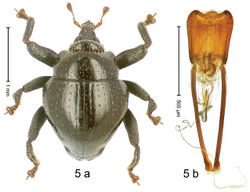Trigonopterus amplipennis
| Notice: | This page is derived from the original publication listed below, whose author(s) should always be credited. Further contributors may edit and improve the content of this page and, consequently, need to be credited as well (see page history). Any assessment of factual correctness requires a careful review of the original article as well as of subsequent contributions.
If you are uncertain whether your planned contribution is correct or not, we suggest that you use the associated discussion page instead of editing the page directly. This page should be cited as follows (rationale):
Citation formats to copy and paste
BibTeX: @article{Riedel2013ZooKeys280, RIS/ Endnote: TY - JOUR Wikipedia/ Citizendium: <ref name="Riedel2013ZooKeys280">{{Citation See also the citation download page at the journal. |
Ordo: Coleoptera
Familia: Curculionidae
Genus: Trigonopterus
Name
Trigonopterus amplipennis Riedel sp. n. – Wikispecies link – ZooBank link – Pensoft Profile
Diagnostic description
Holotype, male (Fig. 5a). Length 2.26 mm. Color black; tarsi and antenna ferruginous. Body subrhomboid; in dorsal aspect with marked constriction between pronotum and elytron; in profile with shallow constriction. Rostrum dorsally dull, with 3 irregular ridges, with rows of erect setae; epistome forming angulate ridge and median denticle. Pronotum with distinct subapical constriction, sparsely punctate with small setiferous punctures, behind subapical constriction scales larger, subclavate, yellowish. Elytra subglabrous, striae weakly impressed, with minute punctures, each puncture with minute seta; apex bordered by curved ridge, median suture incised. Femora edentate. Meso- and metatibia in basal half widened, subapically narrowed. Metafemur with denticulate dorsoposterior edge, subapically without stridulatory patch. Aedeagus (Fig. 5b) widening towards subtruncate, medially pointed apex; transfer apparatus flagelliform, curved, shorter than body; ductus ejaculatorius basally swollen, without bulbus. Intraspecific variation. Length 2.00–2.28 mm. Color of elytra and legs black or ferruginous. Female rostrum dorsally punctate-rugose, in apical half without setae; epistome simple.
Material examined
Holotype (MZB): ARC0556 (EMBL # FN429262), WEST NEW GUINEA, Jayapura Reg., Cyclops Mts, Sentani, S02°31.182', E140°30.542', 1510 m, 30-XI-2007, sifted. Paratypes (ARC, SMNK, ZSM): WEST NEW GUINEA, Jayapura Reg., Cyclops Mts, Sentani: 34 exx, ARC0557 (EMBL # FN429263), ARC0558 (EMBL # FN429264), ARC0559 (EMBL # HE615318), same data as holotype; 14 exx, S02°31.281', E140°30.535', 1420 m, 30-XI-2007, sifted; 7 exx (1 marked ARC0094), 1320 m, 23-XII-2004, sifted; 5 exx, 300–1400 m, 10-VIII-1991.
Distribution
Jayapura Reg. (Cyclops Mts). Elevation: 1320–1510 m.
Biology
Sifted from leaf litter in montane forest.
Etymology
This epithet is based on a combination of the Latin adjective amplus (wide) and the noun penna (wing, elytron) and refers to the basally widened elytra.
Notes
Trigonopterus amplipennis Riedel, sp. n. was coded as “Trigonopterus sp. 40” by Riedel et al. (2010)[1] and Tänzler et al. (2012)[2], respectively “Trigonopterus span” in the EMBL/GenBank/DDBJ databases.
Original Description
- Riedel, A; Sagata, K; Surbakti, S; Rene Tänzler, ; Michael Balke, ; 2013: One hundred and one new species of Trigonopterus weevils from New Guinea ZooKeys, 280: 1-150. doi
Other References
- ↑ Riedel A, Daawia D, Balke M (2010) Deep cox1 divergence and hyperdiversity of Trigonopterus weevils in a New Guinea mountain range (Coleoptera, Curculionidae). Zoologica Scripta, 39 (1): 63-74. doi: 10.1111/j.1463-6409.2009.00404.x
- ↑ Tänzler R, Sagata K, Surbakti S, Balke M, Riedel A (2012) DNA barcoding for community ecology - how to tackle a hyperdiverse, mostly undescribed Melanesian fauna. PLoS ONE 7 (1): e28832. doi: 10.1371/journal.pone.0028832
Images
|
